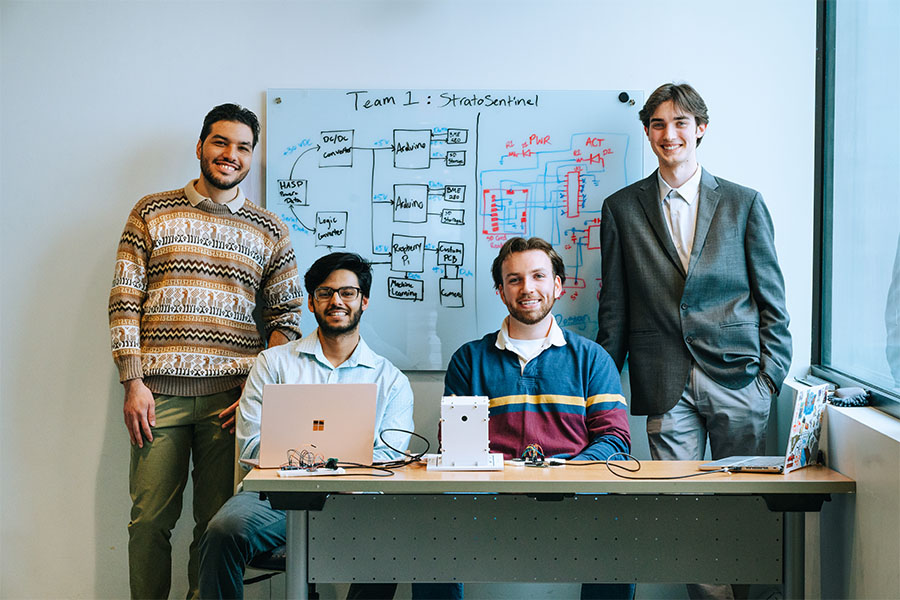- Home
- News
- Recent News
- Engineering Students Selected to Launch CubeSat for NASA-HASP Mission
UMass Boston Engineering Students Selected to Launch CubeSat for NASA-HASP Mission
A team of UMass Boston engineering students was selected to participate in the NASA High Altitude Student Platform (HASP) mission. This will be the first time UMass Boston has been selected to participate in the esteemed program.

The NASA-HASP project will allow the students to send a CubeSat payload into the stratosphere in July 2025. Their payload, the StratoSentinel, is a student-built experimental device launched into the atmosphere by a NASA balloon in order to collect data and test new technology in near-space conditions. The payload will analyze the effects of the extreme high-altitude conditions on low-cost, commercially available electronics.
The team consists of four UMass Boston engineering seniors: Juan Hincapie and Ryan Kelley in Electrical Engineering, and Kaiden Gliniewicz and Aryan Rashid in Computer Engineering, along with their faculty advisor, Dr. Tomas Materdey. Co-PIs include Dr. Theodore Beach of Boston College and university collaborators Ethan Labowitz and Andrew Davis. Their work is being conducted as part of the students’ senior capstone project.
To support their work, the students will have access to UMass Boston’s Engineering Department research facilities, where they will conduct critical validation tests before finalizing the StratoSentinel for launch.
“The team is in the assembly, integration, and validation stage, a critical phase that includes data communication testing and vacuum chamber trials to ensure the CubeSat can withstand high-altitude conditions,” said Materdey.
The proposal for this program consisted of a comprehensive 40-page application that earned them a coveted spot in the mission. The 2025 launch will take place on a large balloon program in Fort Sumner, New Mexico, managed by Louisiana Space Consortium, LSU, supported by the NASA Balloon Program Office.
The conception of their project began with a focus on analyzing ozone depletion, but to keep within their budget they choose a more cost-effective approach. The team was ultimately awarded $1,500 through a UMass Boston research fund to create the low-cost small-scale satellite.
“This mission has provided a better understanding of the overall engineering process from conception all the way to real-world implementation,” said members of the team.“Seeing our ideas come to life over the course of this year has been a rewarding experience, and seeing the final results of our project drives us to create work we are proud of calling our own.”
This July the HASP program will launch 12 student-designed payloads aboard an 11.8-million-cubic-foot scientific balloon, which will ascend over 22 miles above the Earth’s surface.
Materdey said, “Among the Class of 2025 are not only members of the HASP-winning CubeSat team, but also members of UMass Boston’s 2023 NASA MITTIC winning team—demonstrating the exceptional talent and dedication our students bring to their engineering education.”
Their participation in NASA-HASP highlights UMass Boston’s commitment to research-driven and hands-on learning that helps prepare students for their future careers in STEM industries.